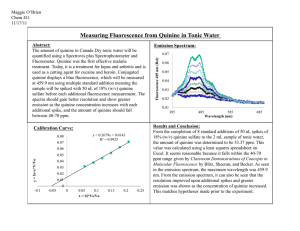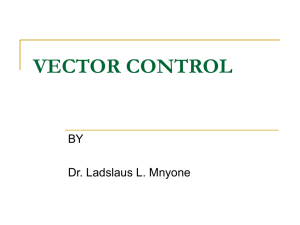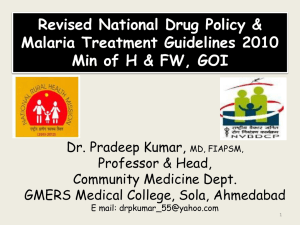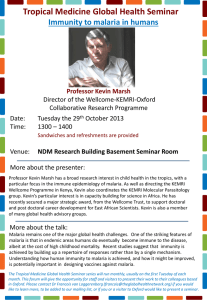NEW IMPERIALISM: MOTIVES AND TACTICS Nineteenth
advertisement
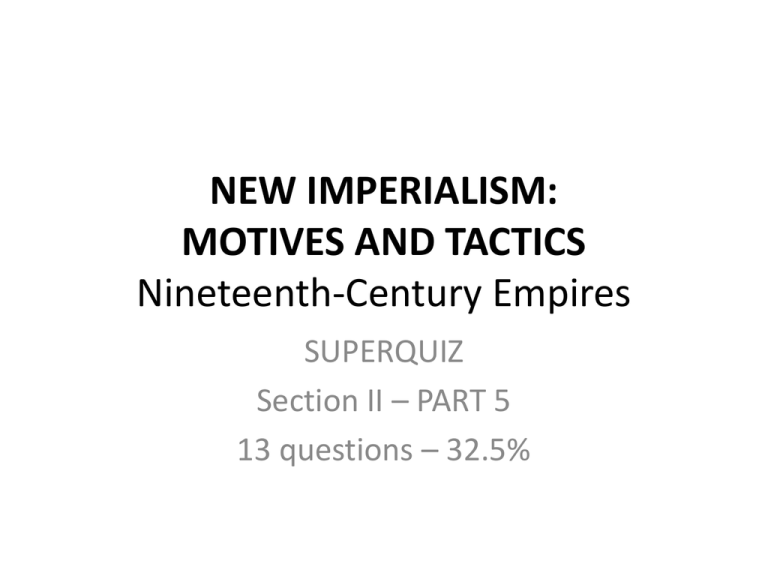
NEW IMPERIALISM: MOTIVES AND TACTICS Nineteenth-Century Empires SUPERQUIZ Section II – PART 5 13 questions – 32.5% The Tools of Empire The Tools of Empire: Technology and European Imperialism in the Nineteenth Century (Excerpts) By Daniel R.Headrick Momentous consequences • Two events of the 19th century had momentous consequences for the entire world – European domination and exploitation of ____________and ________________ – the power and progress of _______________________ • _______________________ – traces the connections between these two events – Historians up to now have only studied these occurrences separately instead of in tandem New imperialism • European imperialism of the 19th century differed in its extent and legacy from previous forms of imperialism – Called _____________________ – In 1800, Europeans controlled or occupied ________of the land surface of the world • _____ by 1878 • _____ by 1914 New imperialism – The British Empire alone experienced substantial increases in influence in the 19th century • In 1800: British empire – ________million square miles and – Population: ______________ • During the 19th Century – The amount of land increased _____________ – the population jumped by _____________ Legacy of New Imperialism • The legacy of new imperialism is hard to quantify • European religious and political ideas marginally remain in Asia and Africa • These ideas are modern equivalents of – Hadrian’s Wall – the Mosque of Cordoba The Triumph of Europe • The real triumph of European civilization has been ___________________ not ________________ – Europeans have prevailed in • • • • • • • • plastics, electricity, printing presses, radio, vaccines, aircraft, napalm, and ships – Very few people currently live without industrial products – The Western conquest of the world with industrial technology remains unchallenged The Triumph of Europe • The European technological triumph began in the 19th century – Europeans wove their technology into their expanding European empires – Connections between technology and history must be studied from both a technological and a historical viewpoint • The history of technology remains a popular form of literature • Bookstores often offer a wide variety of books detailing histories of cars, planes, guns, and furniture – Most of these books are ________________histories • compilations of facts and pictures but are separated from their historical context HISTORY & TECHNOLOGY • The social history of technology aims at comprehending the ________,___________, and _____________of technology – Social historians take a piece of technology and examine it in this view • e.g.,“How did firearms change warfare during the late Middle Ages?” • Reversing these questions also yields insight into the historical process – Examining how technological forces shaped the development of a particular historical phenomenon is an important skill • Historians have failed to answer the question of how technological forces shaped the development of new imperialism Article Focus: The Period of Imperial Expansion • Stages: European imperialism in Asia and Africa • at different times and in different ways – KEY TECH - Europeans penetrated and explored new regions: • Steamers • quinine – KEY TECH -The conquest of indigenous peoples and the imposition of European rule followed • Rapid-firing rifles • machine guns – KEY TECH – estab. of a communications and transportation network • • • • The Suez Canal, colonial railroads, steamship lines, and submarine telegraph cables • Each of these steps involved hundreds of products and processes – Headrick focuses on innovations which either • made imperialism possible or • cost-effective DANIEL R. HEADRICK • Headrick – Doesn’t destroy other interpretations – provokes fresh thinking • Technology = added to the list of factors that historians have explored regarding European imperialism • Imperialism sought to create ___________________ and ________________________colonies – Most territories achieved these aims prior to decolonization – The resulting economic networks and technologies that entered into the development of colonial societies must be left alone for now According to Headrick… • ____________parts of the world experienced ____________effects from technological change during the 19th century – India and Africa were much more affected than Persia or China; the KEY = • The proximity – The attention • Headrick gives to different world regions is representative of the attention that Europeans gave those same regions in the 19th century The European Penetration of Africa: EARLY EXPLORATION • _________________ - coast of Africa in the 1430s – remained the dark continent for 350 + years – The interior of Africa often blank on maps – Europeans chose to explore and conquer • the Americas, • Oceania, and • Asia • Little motivation to penetrate Africa prior to the 19th century – Slave traders sought no disruptions to their profitable operations – Merchants had little evidence of the profitability of penetrating Africa • The penetration of Africa resulted from – missionary and – abolitionist movements against the slave trade European Penetration of Africa • Europeans lacked the ___________ to penetrate Africa – Entering Africa had to be done in dugout canoes or on foot • A series of _______________ covers most of Africa • Rivers flow through a series of __________________from the highlands to the sea • Mangrove swamps and ___________________line African coasts • Animal – trypanosomiasis – nagana ….kill off pack animals in African tropical regions • Europeans, however, had explored the Americas with primitive transportation means • Disease – The effect of European steamships did not have an impact on Africa until decades after their arrival • H.G. Wells could have been writing about it in ______________ – aliens invade Earth in futuristic vehicles – As the aliens are about to conquer Earth, an invisible _______________forces them to flee 142 Portuguese Expeditions • Portuguese captain _________sent an expedition up the ____________River – Casualties reached such high levels within a few days that Cão cancelled the expedition • Francisco _________ led a voyage up the ____________ valley in ________ – The objective was to establish contact with the kingdom of __________________ – _____________________ claimed the cattle and horses miles upriver • The men contracted _________________ – African or part-African agents carried on Portuguese communications with the Zambezi valley until _____ Early European Expeditions • _____ out of 152 Europeans died during William _____ exploration of __________ Bay – This journey lasted from _______ to ________ • Mungo _____ _______ expedition of the upper _______River led to the death of all Europeans involved • Captain James ________ led a party up the ________ River from ______ to _____ – _____ of the 54 Europeans on the voyage died Disease did not restrain European attempts to explore Africa • Each generation: new explorers willing to risk death in order to explore the unknown regions • 19th century: New reasons to explore Africa – A resurgence of Christian mission work, – the abolition of the Atlantic slave trade, and – scientific research funded by the wealthy provided ample motivation to enter Africa Macgregor Laird • played a key role in opening _________to Britain – son of shipbuilder ___________Laird whose • early _____s: firm began building iron steamboats – Macgregor was 23 • Macgregor did not want to remain the junior partner in a struggling business – A restless spirit of exploration stirred him • scientific curiosity, • missionary fervor, and • commercial hope EXPLORING the NIGER RIVER • In _____: Laird’s explores the Niger River – _________________had reached the upper reaches of the river in the first decade of the 19th century • Park reached the __________ Rapids • Brothers Richard and John ___________ traveled downriver in a canoe in 1830 – first ventured north from Lagos – proved that the Niger River and____River were the same river – The Niger River flows into the ________________through a mangrove swamp • Laird realized that a steamer carrying a cargo of trade up the Niger River could open up a large section of Africa to British influence Laird realized steamer’s potential Niger River trade could open up a large section of Africa to British influence …and dats DE truff! ‘‘[This journey will please] those who look upon the opening of Central Africa to the enterprise and capital of British merchants as likely to create new and extensive __________ markets for our manufactured goods, and fresh sources whence to draw our supplies; and those who, viewing mankind as one great _________, consider it their duty to raise their fellow creatures from their present DE________, DE_________________, and DE______________ state, nearer to Him in whose image they were created. The African Inland Commercial established “for the Company commercial development of the recent discoveries of the brothers __________ on the River Niger” • founded by – __________________and – __________ merchants • The treasury refused to grant the company a __________ and a charter, but these setbacks did not slow down the company • ___________Lander was hired to lead the expedition The African Inland Commercial Co.’s THREE SHIPS: –The brig _____________- storeship –Steamships • Quorra • Alburkah • Quorra – –the larger steamship of the journey –________ and __________ built the ship out of ____________ –measured _______by _______ feet –drew _______ feet on the river and _____ feet at sea –__________-horsepower engine –needed a _____-man crew –carried a _____-pound swivel gun, an ___pound carronade, and 8 ____-pound carriage guns, as well as plenty of handguns The Alburkah • M. Laird built the smaller steamship Alburkah – The boat measured ___by ___feet – drew _____feet ____ inches • made of iron except for the deck • Powered by a _____-horsepower _________ and ___________ engine • crew of _______men • Firepower aplenty! – In addition to handguns, – a _____-pounder and – Six ____-pounder swivel guns • The expedition reached the Niger delta without incident – left the ____________ in the Bight of ________, continuing upriver in the two steamers – Laird hoped to found a trading post at the convergence of the Niger and _________ Rivers • sought to buy _________ at low prices EVALUATION of LAIRD’s EXPEDITION • steamers succeeded in navigating the Niger River – Laird earned his reputation as • an explorer and innovator • The expedition as a whole failed to accomplish its ___________ and _____________objectives – Only______out of the 48 Europeans survived the African diseases • Laird returned in a weakened state to England in ______ • He never fully recovered his health 2.18 LISTING (pp. 55-57) • 1. List two momentous events of the nineteenth century according to Headrick. • -industrialization • -colonization of Asia and Africa 2.18 LISTING (pp. 55-57) • 2. List two ways in which the “new” imperialism of the nineteenth century was different according to Headrick. • -its extent • -its legacy 2.18 LISTING (pp. 55-57) • 3. According to Headrick, the goal of imperialism was to create colonies that were • -politically submissive • -economically profitable 2.18 LISTING (pp. 55-57) • 4. Headrick writes that the three stages of imperialism were • -penetration and exploration by first European travelers • -conquest of indigenous peoples • -forging of communication and transportation networks 2.18 LISTING (pp. 55-57) • 5. Key technologies in phase one were • -steamers • -prophylactic use of quinine 2.18 LISTING (pp. 55-57) • 6. The key technologies in phase two were • -rapid-firing rifles • -machine guns 2.18 LISTING (pp. 55-57) • 7. The key technologies in phase three were • • • • Steamship lines Suez canal submarine telegraph cables colonial railroads 2.18 LISTING (pp. 55-57) • 8. Macgregor was motivated by • -missionary fervor • -scientific curiosity • -commercial hope 2.19 MATCHING (pp. 56-57) a. Diogo Cao _____ 1. Scottish shipbuilder 2. founder of the African Inland Commercial Company who b. Francisco Barreto _____ led an expedition up the Niger River without incident until most of them died of disease c. William Bolts d. Mungo Park _____ 3. explorer who led an expedition up the Zambezi River where many of his men succumbed to malaria in 1569 _____ 4. Portuguese captain whose men died in great numbers exploring the Congo River in 1485 e. Capt. James Tuckey _____ 5. 1777-1779 expedition leader at Delagoa Bay where 132 out of 152 Europeans died f. William Laird _____ 6. leader of 1816-1817 exploring party up the Congo River in which 19 out of 54 Europeans died g. Macgregor Laird _____ 7. leader of a 1805 venture into the upper Niger River which resulted in the death of all Europeans present 2.20 FILL IN THE BLANK (p. 57) • You’re cordially invited to join us on a monumental journey led by _______________________. On our passage, the ship _______________________ will be used as a storeship and two ______________________ will also accompany us up the __________________ . 2.20 FILL IN THE BLANK (p. 57) • The larger of the two steamers, the ___________________, is made of wood and was constructed by ____________ and ___________. She measures 112 x 16 feet and is powered by a ____________ - horsepower engine. Altogether _________ men will sail on the Quorra, which will be armed with a 24pound swivel gun, eight 4-pound carriage guns, and an 18pound carronade, a small cannon. 2.20 FILL IN THE BLANK (p. 57) • The smaller of the two ships built by _______________________, son of the great shipbuilder _______________________, is called the _______________________. She is 70 x 13 feet and carries a crew of ______the Quorra, which is made of ______________, the Alburkah is made almost entirely from ______________, except for the deck. She has a 15-horsepower Fawcett and Preston engine and carries a 9pounder and six 1-pounder ____________ guns. 2.20 FILL IN THE BLANK (p. 57) • The previous travels of Richard and John Landers prove that a steamer like ours sailing up river with a cargo of trade will open up an immense part of Africa to the commerce and influence of Great Britain. Join us on our great adventure! • A substantial number of Europeans traded along the coasts of Africa prior to the mid 19th century – The British government stationed a fleet along the West African coast after __________ • This attempt to end the slave trade searched slaving ships suspected of carrying human cargo – The British placed small ___________throughout the coast to enforce the abolitionist goal – Christian missions popped up along the African coasts AFRICAN DISEASES & MORTALITY RATES • All of these Europeans fell ill from African diseases – Statistics regarding mortality rates of British _______________ in West Africa are more plentiful than the rates among _________________ • British troops were stationed in their posts as _________________ became important to Western society – Military criminals and offenders constituted the __________________________ • men traded their ____ sentences for military service in Africa – This swap often constituted a death sentence • The Royal African Corps covered ground from the __________ to the _____________ 1840 MEDICAL ARTICLE on troops in Africa • The United Service Journal and Naval and Military Magazine • an _____ article concerning the health of these troops in Africa TROOPS in SIERRA LEONE – From 1819 to 1836, _____ of the 1,843 troops who served in Sierra Leone died – _________of soldiers – ________worst year for British soldiers in Sierra Leone • ______ out of the 571 men • _________died from disease – The size of the Sierra Leone force decreased by more than ______each year, despite the constant arrival of men THE GOLD COAST • The Gold Coast proved just as deadly as Sierra Leone – _______ of Europeans who arrived between 18__ and 18__ died in Africa – ______ of the 224 men died in 1824 – ______of white soldiers sent to West Africa died – Another __________ became invalids – Only _______of white soldiers returned “fit for future service” CAUSES of MORTALITY Misunderstood • The authors of the 1840 article did not understand the causes of the high mortality rates – The writers did not blame ______________________for contracting diseases – ___________could not take the blame • Dry and windy stations produced as much death as stations next to marshes – The authors faulted _____ fever and __________ fever • The article also featured the death rates of white missionaries to Africa – _____ such men ventured to West Africa between 1804 and 1835 – _______of these men died of disease, while 14 more returned in poor health West Indians vs. Europeans • West Indians only experienced a mortality rate ____ of the white mortality rate – This rate still was double the disease mortality rate of native Africans – An epidemic from 18___ to 18___ in the Gambia killed ______ out of 399 whites • Only ________in 40 to 50 West Indians perished • Yellow fever likely caused this epidemic – Many West Indians had developed a resistance to this disease endemic to the West Indies • By _____, the British government stopped sending white troops to West Africa – Only a half dozen white ___________ arrived in the region to lead West Indian troops Philip Curtin: CHARTMAN! • Faster than a speeding CRAY! • More accurate than, well….Rush Limbaugh! • Sees dead people and loves counting them! Philip Curtin : British personnel mortality rates Curtin: additional statistics for different military groups Malaria • Malaria was the chief killer of Europeans in Africa – OTHER MAJOR KILLERS: • dysentery, • yellow fever, • typhoid – Malaria has likely caused more deaths in human history than any other disease – The protozoan Plasmodium __________ causes TERTIAN malaria • endemic throughout much of the world • leads to – a general weakening of the body – intermittent fevers • Plasmodium_______________causes a far deadlier type of malaria – This strain of malaria is endemic only to tropical _____________ • Savannas, swamplands, and rainforests all house the protozoan – Surviving this type of malaria grants the body only _____________ resistance • Africans often suffered repeated low-level bouts of malaria throughout their lives • Without this limited resistance, however, plasmodium falciparum is often fatal “BAD AIR” • 19th-century European medical experts blamed malaria on putrid smells and humid air – This diagnosis stemmed from the ancient association of malaria and swamps • In ________, mal’aria means “bad air” • The_________word paludisme means “swamp” Laird’s Theory • strangest theory of all • in 1837 • to Thomas _____________ regarding Laird’s expedition of the Niger River It’s real PO WOOD! ‘‘Captain Grant mentioned the possibility of getting firewood at _____________, nothing can be more injurious both to the Vessel and the Crew…to the Crew, as the miasmatic exhalations from it will infallibly produce fever and disease. I have had melancholy experienced of the effects of_________taken on board & used as Firewood for the Engines on the Coast of Africa.’’ ~ Macgregor Laird ALPHONSE LAVERAN • French scientist – Alphonse Laveran • discovered – Plasmodium – in 1880 • This organism invades the – bloodstream VECTOR: Anopheles mosquito • In 18_____, – the British _________, – the Italian ____________ – and the Italian __________________ • discovered the Anopheles mosquito was the __________of malaria Jesuit’s Bark: a remedy for malaria prior to Plasmodium’s 1880 discovery • Technological advances often preceded _________explanations before the 20th century • Science was “_________________” in the age before the 19th century – Nowadays, technology has become “______________” • The ________introduced the bark of the cinchona tree as a cure for _____ malaria in the ___th century – The religious denomination spread news of the remedy throughout Europe – An engraving from the 17th century reads, “______ offers a branch of cinchona to science” Peru, say what? #$%^& JESUITS made me do it! Yo, science! Wanna’ branch? If you need to treat malaria, it’s a CINCHona! CINCHONA’S DRAWBACKS – The tree only grows in the ______ None of that &%@%* Mountains in South America “POPISH” CURE • Limited supplies reached Europe • Often deteriorated or adulterated – _______________doubted the effectiveness of cinchona bark because of the Jesuit connections • Oliver Cromwell supposedly refused the “_____________” cure even when dying of malaria – The bark also had no effect on __________ fever or other widespread fevers at the time for me! New “Killer” Treatments • Up through the 18th century, doctors prescribed cinchona bark for malaria – By the turn of the century, however, medical authorities used _________ and ___________ • Mercury helped with ______________ • calomel used for its ____________qualities – Doctors also began using __________and ______ • These ineffective remedies killed many more patients than they saved • The high death rates of British military personnel in West Africa are partially caused by these deadly “treatments” 1820: Pelletier and Caventou’s big breakthrough – French chemists __________________________and _______________________extracted the ________ quinine from cinchona bark in _________ • Commercial production of quinine began in_________ • By _______, the drug had reached manufacturing levels that allowed it to be used by the general public ALGERIA • Physicians in areas with malaria infestations began conducting quinine experiments in the late 1820s – These medical experts often published results of their investigations – The first important experiments occurred in __________ following the ______ French invasion • __________ and __________outbreaks plagued French troops in Algeria • _____________remained the most common problem Bône experienced the highest Algerian incidence of disease • Swamps surrounded the city • Malaria outbreaks occurred every summer – in 18____: • __________of the 2,788 French soldiers in Bône were hospitalized – in 18____: • _________ out of 5,500 troops were hospitalized – For every 7 of these soldiers that were hospitalized, _______died Mon DIEU, the mortality… 2 :7 ! Good doc Both malaria and its treatments contributed to patient deaths • _______________heavily influenced French army physicians – headed \medical school of – ___________________ Starve the fever and purge the patient! NO quinine until the 7th or 8th attack! Mon dieu! It’s way TOO expensive! • According to Broussais, treat fever with… • • • • bleedings, leeches, purgatives, a starvation diet – Quinine should only be administered after the _____ or ____ ___attack • The drug was too expensive for military use • One ounce cost ________francs Bad Doc! 2 French army docs just say, “NO!” • Jean-André Antonini • François Clement Maillot chose not to follow the accepted medical practices at the time ANTONINI – Antonini noticed that quinine appeared to help _________________ fevers • This realization allowed Antonini to differentiate between malaria and ___________fever • The physician –lessened the __________ of his patients and –gave them more __________ MAILLOT – ______ went further than _________ • The physician arrived in ______in 1834 during the height of the____________ epidemic • At the first sign of malaria, Maillot prescribed ___to ____ grams of quinine immediately – _______________ believed that quinine should be given 4 to 8 days after the first signs of malaria • Maillot put his patients on a nutritious diet – Only________in 20 of Maillot’s patients died in 1834 – Recall the figure was _______ in 7 for 1833 Recognition for Maillot • In 18___ Maillot described his treatment methods for malaria to the _________________________in Paris – In 18___, he published his findings in the work ________________________________________ – The French military ___________accept Maillot’s methods for years • In 18___, Maillot received the recognition he deserved – France revered Maillot as a ________of French science – The ____________________________stated, “It is thanks to Maillot that Algeria has become a French land; it is he who closed and sealed forever this ________________________” QUININE • Quinine use became more widespread in _________________as well – Purgings and bleedings gradually fell into disuse – By the 1840s, Gold Coast Europeans kept jars of quinine _______ around their house • The first sign of chills or fever resulted in ingesting this medicine • Quinine use after infection only combated ___________malaria – To prevent Plasmodium_____________, quinine needed to saturate the human bloodstream _________infection occurred • Quinine was taken as a ________________ during one’s stay in areas known to be infested with falciparum Two events led to discovery of quinine as a prophylactic • EVENT #1: –In _________ –the ship ___________was stationed off the coast of Sierra Leone • _______ crew members took cinchona bark regularly, while _____officer refrained from doing so • Only ___________died of malaria EVENT #2: • In 18______, the British government sponsored the largest ever Niger expedition • Captain H.D. _________ led ________Europeans up the Niger River aboard – the 457-ton Albert, – the 457-ton Wilberforce, and – the 249-ton Soudan • Every known precaution was taken to protect these men from disease – Only young and athletic men of “good breeding” had been selected – The ships had fans to dispel bad air – The expedition barreled at top speed up the malaria-infested Niger delta to reach the dry upper river as soon as possible • Malaria still appeared on board the ships within three weeks – The Wilberforce and the Soudan returned to the Atlantic Ocean as floating hospitals – Within two months, ________ Europeans had died • Another _____ perished before the expedition ended Dr. T.R.H.Thomson • Dr. T.R.H. Thomson used the opportunity as the physician on board one of Trotter’s ships to experiment with different drugs – Some crew members received cinchona bark with wine while others got quinine – Thomson gave quinine to himself and stayed healthy – The physician published his findings in the article On the Value of Quinine in African Remittent Fever • The work appeared on February 28, 1846 in the British medical journal The Lancet Dr. Alexander Bryson’s Report • Dr. __________________ – in 18________ • published Report on the ___________ and ________________of the African Station • advocated the use of quinine as a _________________ to Europeans in Africa • By 18____, – the director-general of the Medical Department of the ______________sent a notice to all West African British __________ recommending quinine prophylaxis Quinine prophylaxis still did not receive immediate adoption by the medical community • _____________________proposed another African expedition in 18_____ – Laird had the ship __________specifically built under his contract with the Admiralty • This ________ propeller-steamer weighed ______ tons • The ship rigged as a schooner – She had the capacity to pull 2 or 3 barges up the Niger • A ____-pounder pivot gun, 3 smaller swivel cannons, rifles, and muskets defended the Pleiad • _____Europeans and ___Africans formed the ship’s crew BRYSON & BAIKIE • Dr. Alexander ___________ gave a set of instructions to protect the crew’s health – These directions delineated clothing, diet, activities, and moral influences – Bryson recommended the crew take ____ to ____ grams of quinine per day during the Voyage • The time period of this quinine use spanned from the time the ship crossed the sandbar to 14 days after venturing back into the Atlantic Ocean – Dr. William _________ made sure the crew followed these instructions • Baikie served as ______________ of the Pleiad – After 112 days on the ________&_________Rivers, all European crew members returned alive • Thomas _________________ gave Dr. Bryson the credit he deserved for this technological miracle ______________________: Pleiad’s Senior Surgeon ‘‘Since my first visit to Africa in 1850, I have felt firmly convinced----and that conviction urges me to impress my faith on all who read this work----that the climate would not be so fatal as it has hitherto proved to Europeans, if a different mode of daily living, a proper method of ________________________ hygiene, and another line of therapeutic practice in the treatment of fevers, were adopted. Before, and beyond all others, is the ____________ influence of quinine as it was used in the ‘‘______________,’’ in the mode here described…’’ ~ Thomas Hutchinson _______________’s Mortality Stats • Death rates from malaria plummeted as quinine as a prophylactic spread – Bleedings and purgings fell out of favor as accepted medical practices Philip Curtin ‘‘The improvement over the recent past was understood well enough in official and missionary circles to reduce sharply the most serious impediment to any African activity.’’ • Only _____ of the 2,500 European soldiers involved in a two-month military expedition against ________ died – _____________mortality rates for Europeans in West Africa also rapidly dropped off – The rate fells from ________-per 1,000 to __________ per 1,000 – This lower rate still represents ____________times the death rate of European people in the same age bracket back in Europe European exploration of Africa continues • European exploration of Africa increased in the mid 19th century with the advent of successful malaria prevention – Expeditions remained dangerous but no longer had ______________levels of danger – Countless Europeans volunteered to search for glory and wealth in Africa • The most celebrated of these celebrities was _________________________ LIVINGSTONE • Livingstone first heard of quinine prophylaxis in ________________________in ________ – He took quinine daily while marching across southern Africa from 18____to 18____ – By 1857, Livingstone became convinced that quinine prevented malaria – When preparing for an expedition of the __________ River in 18____, Livingstone made his crew take two grams of quinine a day in their sherry • Many of the crew suffered from malaria on the trip • Only _______of the 25 died • Livingstone developed a remedy for malaria from rhubarb, quinine, calomel, and resin of julep – The explorer modestly called this concoction ___________________ pills (“LIVINGSTONE ROUSERS”) • Livingstone came to doubt quinine’s efficacy, as it only lessened the impact of malaria Growing demand for quinine • Europeans followed the footsteps of intrepid explorers into Africa – Planters, engineers, traders, missionaries, administrators, tourists, and soldiers, as well as their wives and children, ventured into Africa • All of these groups needed daily quinine to treat malaria – Europeans in ________ and other tropical areas also demanded quinine Growing demand for quinine • Until the 1850s, these areas served as the only sources for the world’s cinchona bark supply • • • • Brazil, Colombia, Ecuador, and Peru • in 1881 – Bark exports rose from ____million pounds in 1860 to ____ million – In 1881, Indian and ____________________ cinchona bark took bark from the Andes off the market • The _____________and _______________caused this market shift to occur • Ideas about growing cinchona trees in Asia circulated for a long time – While demand for cinchona bark was small, the plans never came to fruition CINCHONA in ASIA • In the early 18____s, Dutch botanists in ______ advocated for the government of the Netherlands East Indies to import cinchona seedlings – From 18___to 18___, Justus Charles ____________ traveled to the Andes under an assumed name • This superintendent of the _____________________Botanical Gardens secretly collected seeds • Most of these seeds died on Hasskarl’s journey back – From 18___to 18___, Clements ___________ and _______ traveled to Bolivia and _______ • Markham worked as a clerk at the __________ Office • Weir found employment as a gardener at the British Royal Botanic Gardens at ____________ • Markham and Weir sought to collect seeds of the Cinchona ____________________tree CINCHONA at OOTACAMUND in INDIA’s ___________ Hills • English botanist Richard ________ and Kew gardener Robert _______ traveled to ______ at the same time as Markham and Weir’s mission – Spruce and Cross collected 100,000 Cinchona ____________ seeds and 637 plants – ______ seedlings reached India – These plants formed the center of cinchona plantations at _______________________in the Nilgiri Hills near Madras A period of experimentation followed these secret expeditions • Horticulturists and other scientists exchanged seeds and information at botanical gardens in Java, Madras, Ceylon, and Bengal – These gardens provided cheap seedlings and advice to planters • After 1874, Cinchona calisaya __________________ formed the basis of Javanese cinchona plantations – This hybrid species grafted onto the stem of the C. ________________ tree • __________and____________also increased the quinine yield – Mossing - cutting strips of bark and placing moss around the trees – Coppicing -deals with cutting trees to the ground after 6 or 7 years • Peruvian cinchona bark had a ________sulphate of quinine content – Breeding in Java raised this figure to ________ by 1900 – Scientists later improved this number to _______ or ________ The British and Dutch reached a compromise after the collapse of the Andean bark industry • ___________ plantations produced a cheaper but less potent bark – From which chemists extracted ____________________ • Totaquine : a mixture of antimalarial ________________ – Almost all of India’s production of cinchona bark went to British ___________&_________________personnel stationed in the tropics • The excess was sold in the Indian market • _____________horticulturists produced the more expensive and potent pure quinine – This version of quinine captured over ________% of the world quinine market by the early 20th century • Scientific cultivation methods and a marketing ___________caused this monopoly • The Kina Bureau of Amsterdam coordinated the purchase of bark as well as the price and quantity of quinine sold – _____________control of the quinine market only ended after the Japanese conquest of Indonesia in World War II • The development of _____________________malaria suppressants also contributed to the decline of this monopoly Scientific cinchona production – A high point of imperial technology • European could not have colonized Africa without it – Colonization in other areas would have been much more ______________ • This new advancement, however, was as much a _____________ of new imperialism as it was a consequence – Several botanical gardens shared their scientific expertise – ___________& ___________colonial government encouraged the development of scientific cinchona production – ___________&___________________land and labor contributed to the technology 2.21 CHARTING (pp. 57-61) 2.21 CHARTING (pp. 57-61) 2.22 TRUE OR FALSE (pp. 58-59) 1. West Indian soldiers on the West African coast had a better resistance to disease than the white soldiers they served with True 2.22 TRUE OR FALSE (pp. 58-59) 2. The British government never recognized the significance of soldier death rates in West Africa due to disease. • False—They finally recognized the significance in 1830 and began sending mostly West Indian soldiers there because of their greater resistance to disease. 2.22 TRUE OR FALSE (pp. 58-59) 3. The principal killer of Europeans in Africa was yellow fever. False—The principal killer was malaria. 2.22 TRUE OR FALSE (pp. 58-59) 4. Macgregor Laird believed that malaria was caused by firewood from a certain location. TRUE 2.22 TRUE OR FALSE (pp. 58-59) 5. Alphonse Laveran discovered that malaria was transferred via mosquito bites. • False—He discovered that malaria was caused when Plasmodium invades the bloodstream but didn’t know that mosquitos were the vector. 2.22 TRUE OR FALSE (pp. 58-59) 6. A remedy for malaria was discovered long before the 19th century through trial and error. TRUE 2.22 TRUE OR FALSE (pp. 58-59) 7. The bark of cinchona trees was an effective and easily disseminated cure prior to the 19th century. • False—It was effective but it only grew in the Andes Mountains so the supply in Europe was limited and often deteriorated by the time it reached the European continent. 2.23 COMPARISON (pp. 58-60) • This or that? For each item below, determine whether it describes the Plasmodium Vivax strain (PV) or the Plasmodium Falciparum (PF) strain of malaria. 1. Endemic only in tropical Africa 2. Endemic throughout much of the world 3. The less deadly of the two strains 4. Causes a general weakening of the body and produces intermittent fevers 2.23 COMPARISON (pp. 58-60) 5. Generally can be treated with quinine pills at the first sign of chills or fever 6. The body’s resistance to this strain is only temporary 7. The bloodstream must be saturated with quinine before the onset of first infection in order to cure this strain 8. The deadlier of the two strain 9. Jesuits introduced the bark of the cinchona tree as a cure to this strain 2.24 CHARTING (pp. 58-60) 2.24 CHARTING (pp. 58-60) 2.24 CHARTING (pp. 58-60) Steamers: Comparison to quinine • Steamers helped Europeans overcome the stumbling block of poor transportation – Similarly, quinine cleared the obstacle of malaria for Europeans • Quinine and steamers worked hand in hand to open much of Africa to colonialism • The scramble for Africa is often explained as a complex interplay of political factors – The French political psychology following the __________________ War ostensibly allowed new imperialism to take place • ________________ also held lofty ambitions for an expanding empire • Historians also attribute the scramble for Africa to be a byproduct of the _____________________ – Headrick feels that technology such as these equally contributed to the scramble for Africa • steamers, • quinine prophylaxis, and • the quickfiring rifle • Quinine prophylaxis protected European crews aboard steamers heading into Africa Macgregor Laird’s Back: Economic Motives • The Niger trade proved both lucrative and necessary for Britain • After the fall of the slave trade, _____________served as southern Nigeria’s chief export – Europeans used palm oil • to make soap and • lubricate industrial machinery • Niger delta middlemen kept the price of palm oil unreasonably high – These merchants brought palm oil to the coast to trade with Europeans – Small European traders who shipped palm oil to Europe also raised the price of palm oil • Laird believed that the ____________would break these _____________ grips on the __________export business • Laird wrote to ____________in 1851 that _________________ “will convert a most uncertain and precarious trade into a regular and steady one, diminish the risk of life, and free a large portion of the capital at present engaged in it…” The double application of steam • Europeans required the double application of steam – One application was a regular steamboat service along ____________________________ • This service bypassed the Nigerian middlemen in the palm oil industry – The other was the development of a steamship line between _________and______________ Macgregor Laird • Laird’s first appeals were rejected – The 1854 expedition of the Pleiad gave credence to Laird’s ideas – The _____________________________convinced the British government to support Laird’s projects in ____ • In 1857, the Foreign Office sent Dr. _______ to open relations with the Caliphate of ________on the middle Niger – The Admiralty signed a contract with Laird • Three steamers would be sent up the Niger River annually for the next _______years Niger River Steamers • John Laird’s Birkenhead shipyard built the – Dayspring, – Rainbow, and – Sunbeam for this service ….DRS of British commerce! • These three ships’ journeys angered the Nigerian middlemen whom they were bypassing – Traders attacked the _____________ in 18____, killing _______ crew members • Laird subsequently asked the British government to have a _______________accompany the steamers WARSHIPS and GUNBOATS • In 18___, the H.M.S. _________entered the Niger River – This warship destroyed the villages that had been responsible for the Rainbow attack • By the 1870s, several British companies traded with armed steamers on the Niger – A military expedition annually destroyed towns that resisted the British invasion • By the 1880s, the ________________________kept a fleet of light gunboats on the Niger River throughout the year – Sir George _________ headed this company that united all trading interests in the region • In 1885, the British government declared the Niger delta a ___________________ – Sporadic resistance occurred in the region • No African river town could effectively fight against British gunboats Beyond the Niger • The Niger River became the earliest and most active background for the use of steamers by Europeans • This river was the easiest African tropical river to navigate • Other African Rivers: – The Congo, – Zambezi, and – upper Nile as well as their tributaries all contained waterfalls that blocked steamers’ progress • Boats needed to be disassembled, portaged, and then reassembled to bypass the cataracts • These portages required large-scale financing, labor, organization, and technology that Niger explorers never acquired Livingstone’s Steamers • In 1858, David Livingstone used the ______________to explore the Zambezi River up to the ________________ Rapids – Livingstone utilized 2 others: • the Pioneer in 1861 and • the Lady Nyassa The MA ROBERTS The LADY NYASSA • The Lady Nyassa had to be carried in pieces around the waterfalls leading to _________________ Various Explorers Used Small Steamers • ____________________ explored the upper Nile with the steamer Khedive • __________________had the nine-ton steamer En Avant carried in pieces from the Atlantic Ocean to Stanley Pool • _____________________ soon appeared on the Congo River with his Ballay Savorgnan de Brazza • on the _______ River • with his __________ The number of European steamers on African rivers soon drastically increased • MOTIVATION: – Missionary work, – trade, – exploration, and – conquest Small Belgian Trading Steamer • French lieutenant ___________ conquered – Lake __________ and the area of the – _________and ________Rivers from 18__ to 18__ • Gentil used the first aluminum steamer _______ in these expeditions Commandant Marchand • Marchand embarked on a cross-Africa adventure in 18______ – Two steamers and three rowboats portaged from the Ubangi to the _____ for this expedition – After reaching the Nile, Marchand rode his steamboats up to his confrontation with ___________at________ Without Steamers, Europeans Couldn’t Have Penetrated Africa • The lack of ____________ and Africa’s harsh ______________would have slowed down expeditions that traveled on foot – African regions that lacked good water transportation were some of the last global regions to be colonized • These areas included – – – – Ethiopia, the Kalahari, Central Sudan, and the Sahara • The ease of water transport and difficulty of land transport defined European interactions with Africa during the 19th century 2.25 COMMONALITIES (pp. 61-63) • • • • • Hasskarl Markham Weir Spruce Cross • Attempted to get cinchona seeds to plant 2.25 COMMONALITIES (pp. 61-63) • • • • Quinine, Calomel, Rhubarb, Resin of Julep • Ingredients in “Livingstone Pills” 2.25 COMMONALITIES (pp. 61-63) • • • • Peru Ecuador Bolivia Colombia • The only sources of cinchona bark until the 1850s 2.25 COMMONALITIES (pp. 61-63) • • • • • • Missionaries Soldiers Traders Administrators Planters Tourists • “Lesser protagonists” in imperialism who could finally travel inland once a preventive cure for malaria was discovered 2.25 COMMONALITIES (pp. 61-63) • • • • Bengal Ceylon Madras Java • Places were horticulturists and quinologists exchanged seeds and information 2.25 COMMONALITIES (pp. 61-63) • Dayspring • Rainbow • Sunbeam • Ships built by Laird’s Birkenhead shipyard for service between Britain and West Africa 2.26 DEFINITIONS (pp. 60-63) A technique used to increase the yield of alkaloids where one cuts strips of bark and wraps cinchona trees in moss Coppicing Quinine prophylaxis David Livingstone 2.26 DEFINITIONS (pp. 60-63) Captain of the Pleiad and a doctor who made sure his crew took quinine during their travels up the Niger and Benue rivers Palm Oil A marketing cartel which coordinated the purchase of bark and the price and quantity of quinine sold until the early 20th century 2.26 DEFINITIONS (pp. 60-63) Niger River First steel steamship which Livingstone used to explore the Zambezi River in 1858 2.27 QUOTING (pp. 57-62) Macgregor Laird Scientific Congress of Algiers Written about Laird’s missionary fervor and desire to Christianize and civilize Africans Dedication to Maillot who was finally honored at the end of his life for his contributions to science because of his use of quinine to cure malaria 2.27 QUOTING (pp. 57-62) Macgregor Laird Thomas Hutchinson Written in a letter to Thomas Peacock in 1837, Laird tried to explain the origin of the malaria epidemic Written by a member of the crew of the Pleiad about the suggestions for the prevention of malaria given to them by Dr. Alexander Bryson 2.27 QUOTING (pp. 57-62) Philip Curtain Magregor Laird Comments about the way in which Africa was no longer the “white man’s grave” once an effective cure for malaria was found Written in 1851 to Earl Grey, Laird believed that the steamship was the key to successful commerce in the interior of Africa 2.28 ANALOGIES (pp. 57-62) RIVER STEAMERS • 1. ____________________________: poor transportation :: quinine : malaria • 2. Alburkah : iron ____________________________:: Quorra : wood 2.28 ANALOGIES (pp. 57-62) • 3. Mungo Park : Niger River :: Francisco Zambezi Valley Barneto : ____________________________ • 4. Paludisme : French :: mal’aria : Italian ____________________________ 2.28 ANALOGIES (pp. 57-62) gardener • 5. Weir : ____________________________:: Spruce : botanist • 6. Bark of cinchona tree : prevention of Palm oil malaria :: ____________________________: lubrication of industrial machinery 2.28 ANALOGIES (pp. 57-62) • 7. Macgregor Laird : Scotland :: King Leopold II : ____________________________ Belgium • 8. Pelletier : chemist :: Cross : gardener ____________________________ 2.29 EITHER/OR (pp. 61-62) • In order to address the growing (DEMAND FOR, SUPPLY OF) quinine an attempt was made by the British and the (DUTCH, FRENCH) to grow (CINCHONA, POPLAR) trees in areas outside of the Andes Mountains 2.29 EITHER/OR (pp. 61-62) • . In 1853-54 Justus Charles Hasskarl traveled to the (ANDES, HIMALAYAS) under an assumed name and (SECRETLY, ALLEGEDLY) collected seeds, most of which (DIED, SPROUTED). 2.29 EITHER/OR (pp. 61-62) • Later in 1858-1860, Markham and Weir traveled, again secretly, to collect (SEEDS, YOUNG PLANTS) of the Cinchona Calisaya tree. At the same time, an (ENGLISH, AMERICAN) botanist Robert (SPRUCE, PINE) and a gardener Robert Cross collected specimens in (ECUADOR, PERU). 2.29 EITHER/OR (pp. 61-62) • Of the 100,000 seedlings and 637 young plants only 463 seedlings reached (INDIA, ALGERIA) forming the nucleur of the cinchona plantations at Ootacamund in the Nilgiri Hills near (MADRAS, BENGAL). 2.29 EITHER/OR (pp. 61-62) • After extensive experimentation and the eventual demise of the Andean bark industry, a compromise was worked out between the (BRITISH, FRENCH) and the (DUTCH, GERMANS). Plantations in (INDIA, CHINA) produced a cheaper, less (POTENT, CONTAMINATED) bark from which chemists extracted totaquine, a mixture of antimalarial alkaloids. 2.29 EITHER/OR (pp. 61-62) • Most of this product was reserved for (FRENCH, BRITISH) military and personnel stationed in the (TROPICS, COASTAL AREAS). The rest of the product was sold in (FRANCE, INDIA). The quinine made by the (DUTCH, FRENCH) was more potent, (PURE, CONTAMINATED), and (CHEAP, EXPENSIVE). It made up over (FIFTY, NINETY) percent of the world market in the early twentieth century. 2.30 ORDERING (pp. 59-63) • ____Laird’s 3 expedition on the Pleiad • ____ 1 Two French chemists Pelletier and Caventou extracted the alkaloid of quining from the bark of cinchona trees The Espoir destroyed the villages that had been • ____ 7 responsible for the previous assault on the Rainbow • ____ 4 Foreign office agreed to send Dr. Baikie to open relations with the Caliphate of Sokoto on the Middle • 5 Niger ____ Livingstone used the Ma Roberts to explore the • 2 Zambezi River up the Kebrabasa Rapids ____ David Livingstone first heard of quinine • 6 prophylaxis ____ Delta traders whose business was threatened attacked the Rainbow IN ORDER • (1820) Two French chemists Pelletier and Caventou extracted the alkaloid of quining from the bark of cinchona trees • (1843) David Livingstone first heard of quinine prophylaxis • (1854) Laird’s expedition on the Pleiad • (1857) Foreign office agreed to send Dr. Baikie to open relations with the Caliphate of Sokoto on the Middle Niger • (1858) Livingstone used the Ma Roberts to explore the Zambezi River up the Kebrabasa Rapids • (1859) Delta traders whose business was threatened attacked the Rainbow • (1861) The Espoir destroyed the villages that had been responsible for the previous assault on the Rainbow STOP
